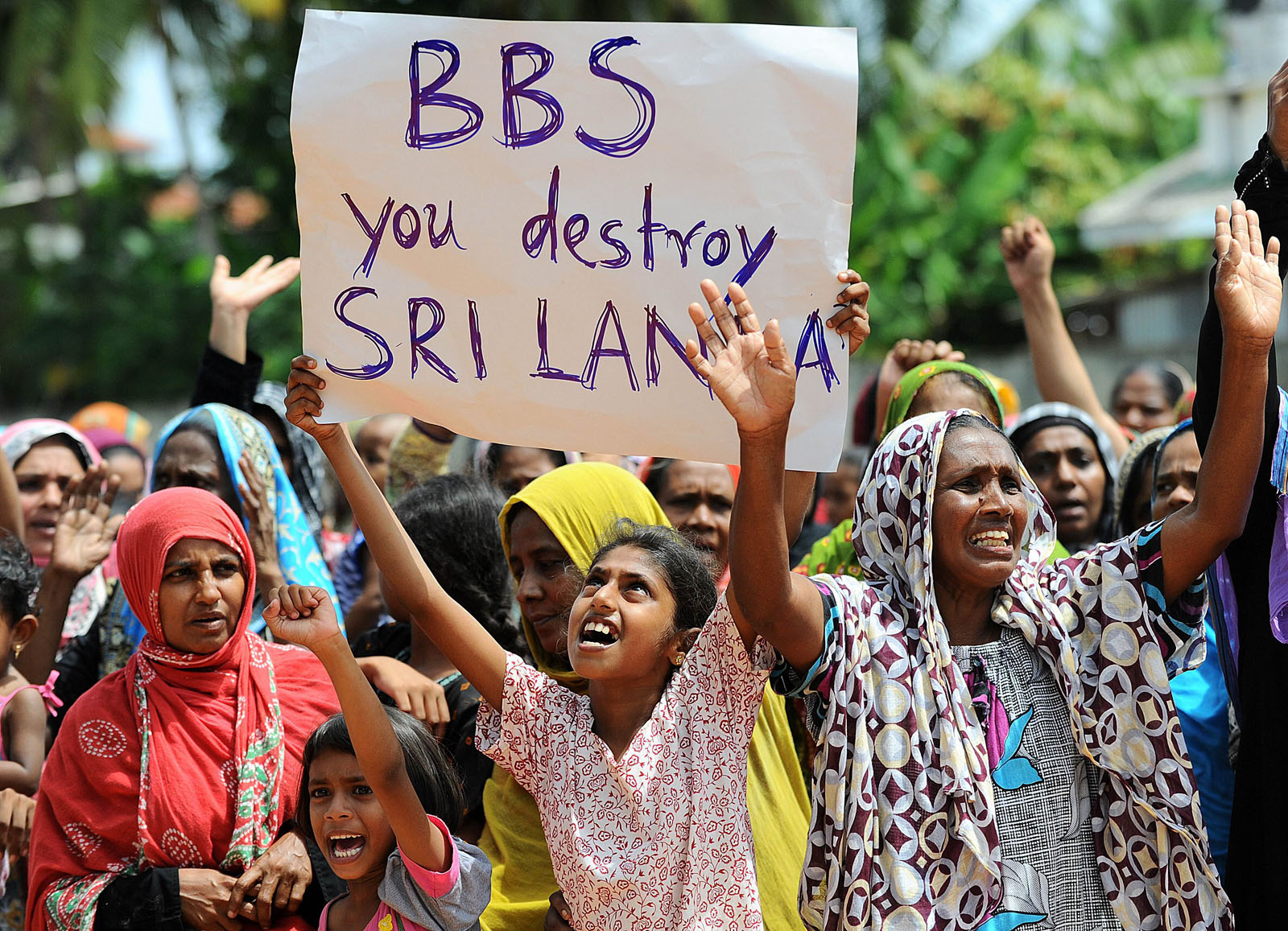AFP PHOTO/ Ishara S. KODIKARA via The Straits Times
Mobs on the streets, houses being burnt, people being attacked due to their race or religion, some being killed, the law enforcement and security services unable or unwilling to arrest the situation, that describes the streets of Colombo and the rest of the country in July 1983 and thirty years later, after a bloody civil conflict was brought to an end, we were at it again as a nation. Back then it was the Tamils, with a UNP President and administration, this time around it was the Muslims and the President and administration was SLFP. We seem to have a bi partisan problem with justice and social harmony. Paradoxically a nation which prides itself on an ancient history based on a tradition and religion of kindness and tolerance, has become an intolerant and violent society. During the war with the LTTE, we blamed every atrocity on the exigencies of fighting a brutal foe. However neither the victims of July 1983 nor those of June 2014 were armed opponents of the state or civilians caught in the “fog of war”. They were ordinary fellow citizens and clearly we failed them and ourselves. The death and destruction was not on the battle field, it was on the streets of our cities. Sri Lanka’s peace is a violent peace and we wonder why the world through the UNHRC keeps telling us in resolution after resolution, that our post war reconciliation is deficient and our democratic and human rights sadly wanting. The government acts indignant, but the reality of the ground situation is that the concerns are more than justified, not just internationally but domestically too.
The Sunday Times editorial of 22nd June 2014, put it this way. “It is the supreme irony of our time that, in claiming to defend Buddhism, a handful of monks with their hate speech and instigation to violence have managed to do quite the opposite. The mob attacks this week on Muslim houses and businesses in Aluthgama, Beruwela and Dharga Town drew international censure. Attracting equal if not more alarm was video footage of a radical Buddhist monk spewing revulsion and animosity at the Muslim community during a public rally just hours before violence broke out. It is not the first time he has done this”.
Initial reports would indicate that there was certainly a clear enabling environment created for the violence to occur. An altercation which had occurred between a venerable monk or rather the driver of his trishaw and some youth was used several days later to spew venom and create the necessary background for an attack on the Muslim community. The altercation itself, was quite correctly handled by the local law enforcement, suspects were in custody and the matter was before courts. However, the incident was used as a pretext for launching a hate campaign and a violent attack. That the violence was expected and anticipated by community and political leaders is made evident by the concerted efforts of Transport Minister Kumara Welgama, the UPFA leader for the Kalutara District, who did his best to get the meeting banned.
Again the Sunday Times, puts it this way, “In this country, brute force is used to crush labour and student protests, while court orders are secured at the drop of a hat to deprive the populace of their right to assembly. This time despite the very real prospect of violence, the precaution taken was pitifully inadequate and action came too late”.
The DIG of the area, refusing Minister Welgama’s request to ban the meeting, raises the very real question as to where the DIG got the guts to do so. Was there someone more powerful than a minster instructing the DIG to allow the meeting to proceed. Seemingly in response to that question, the UNP, through its Media Spokesman and director of political affairs, former Foreign Minister Hon. Mangala Samaraweera, has in a public and official statement claimed, that the BBS is a government backed organization and that it was fueling communal tensions.
The BBS is termed a “terrorist organization” by international defense analysts, Minister Vasudeva Nanayakkara wants them banned, Minister Rishard Bathuideen wants them brought before the law, Minister Rauff Hakeem is wringing his hands in public and supposedly hanging his head in shame at being in the government, Minister Kumara Welgama does not want them anywhere near his electoral district, almost all other Buddhist clergy and lay leaders disown their venom and their violence. Despite all this, the BBS rides on and rides high. Protected by an unseen hand, they spew hate against minorities, break up news conferences they disagree with, witness their opponents even in the Maha Sanga, such as Ven.Watarake Vijitha slashed with a blade, get prime land to build high rise headquarters in the heart of Colombo and clearly never fall foul of the law.
Paradoxically though, all this works to the political advantage of the Rajapakse Administration. Sadly in the world of real politic and especially in the run up to an election cycle, with crucial presidential and parliamentary polls expected early next year, after the Uva provincial poll, there is little reason to hope for a change. The Sinhala nationalist elements and their leaders, such as Ministers Champika Ranawaka and Wimal Weerawansa, who were dissenting and distancing themselves from the Administration on the issue of gambling and the casinos, flocked back to defend the Administration from criticisms by the Muslim ministers and left leaders. Nothing like a bit of minority bashing to get the hawks to flock together. In his defense, President Rajapakse did visit the affected areas, spoke with Muslim leaders and promised some form of compensatory redress, all of which was more than what President Jayawardena did after July 1983. But we should have learnt very much more since then. Those who fail to learn from the lessons of history are forced to relive them.
